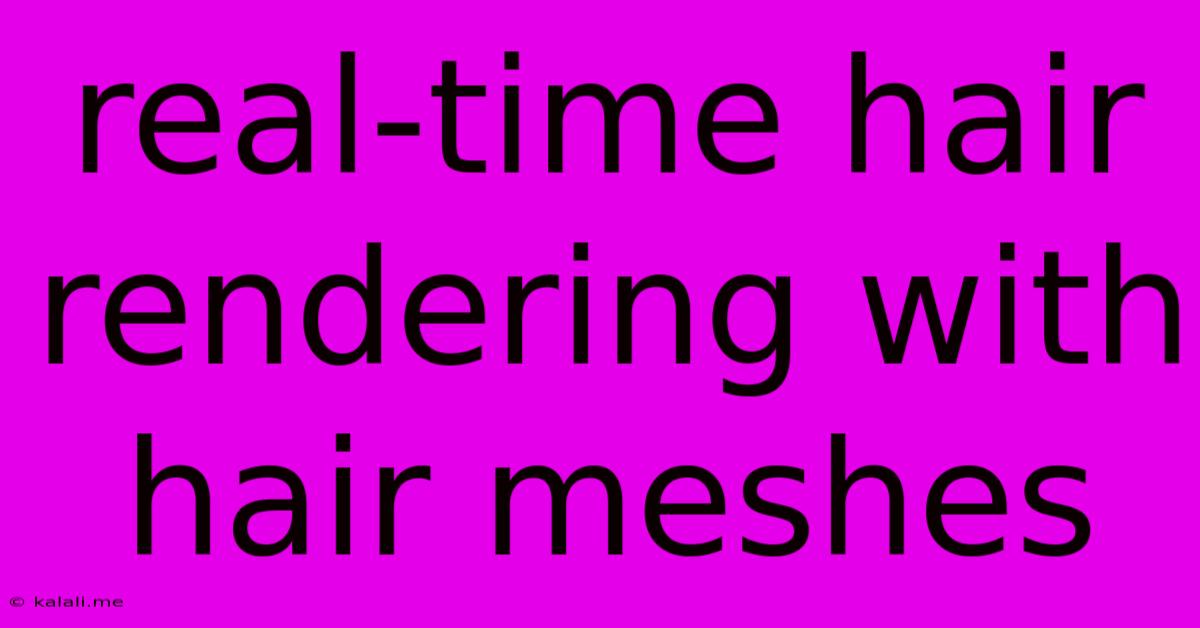Real-time Hair Rendering With Hair Meshes
Kalali
May 31, 2025 · 4 min read

Table of Contents
Real-Time Hair Rendering with Hair Meshes: A Deep Dive
Meta Description: Learn the techniques behind real-time hair rendering using hair meshes. Explore different approaches, challenges, and the future of realistic hair in games and interactive applications. This guide covers everything from mesh generation to advanced rendering techniques.
Real-time rendering of realistic hair has long been a holy grail for game developers and interactive application creators. Gone are the days of simplistic, helmet-like hair representations. Today, thanks to advancements in both hardware and software, achieving convincingly realistic hair in real-time is increasingly feasible. This article explores the key techniques involved in rendering hair using hair meshes, examining the challenges and the exciting possibilities that lie ahead.
Understanding Hair Mesh Generation
The foundation of realistic hair rendering lies in the creation of a suitable hair mesh. Unlike standard polygonal meshes, hair meshes require a specific structure to accurately represent the individual strands and their complex interactions. Several methods exist for generating these meshes:
-
Manually Created Meshes: This is a highly labor-intensive approach, offering maximum control but proving impractical for large-scale projects or characters with voluminous hairstyles. It's typically reserved for high-end cinematic rendering or specific character details.
-
Procedural Generation: This is the preferred method for real-time applications. Algorithms generate hair strands based on various parameters, such as hair length, density, root position, and curliness. These algorithms often employ techniques like L-systems or particle systems to simulate hair growth and movement. The complexity and realism of the generated hair depend heavily on the sophistication of the algorithm used.
-
Hair Simulation and Capture: Advanced techniques involve simulating hair physics and capturing real-world hair movements using specialized scanners. This data can then be used to create high-fidelity hair meshes, offering a level of realism difficult to achieve through purely procedural methods. However, this approach can be computationally expensive.
Rendering Techniques for Hair Meshes
Once a hair mesh is generated, efficient rendering techniques are crucial for real-time performance. Several strategies are commonly employed:
-
Strand-Based Rendering: This technique renders each hair strand individually, offering high fidelity and allowing for the simulation of individual strand interactions and shading variations. However, it can be computationally expensive for dense hairstyles. Optimizations, such as level of detail (LOD) techniques, are essential for maintaining performance.
-
Card-Based Rendering: This method approximates hair strands as thin rectangular cards or ribbons, significantly reducing the polygon count compared to strand-based rendering. While less detailed, it offers a good balance between visual quality and performance. Careful manipulation of card alignment and shading can still produce convincing results.
-
Point-Based Rendering: Instead of representing hair as meshes, this approach uses points to define the hair's position and properties. This drastically reduces the rendering overhead, making it suitable for extremely dense hair. Advanced shading techniques can compensate for the loss of geometric detail.
-
GPU-Accelerated Rendering: Modern GPUs are highly optimized for parallel processing, making them ideal for the computationally intensive task of hair rendering. Utilizing shader programs and optimized data structures is crucial for leveraging the full potential of the GPU.
Challenges and Future Directions
Despite the advancements, real-time hair rendering still faces several challenges:
-
Computational Cost: Rendering realistic hair can be extremely demanding, requiring significant processing power, especially for high-density hairstyles and complex simulations.
-
Self-Occlusion: Accurately rendering the self-occlusion of hair strands is crucial for realism. Efficient algorithms are needed to handle this complex interaction.
-
Realistic Shading and Lighting: Achieving accurate shading and lighting effects on hair, including highlights, reflections, and subsurface scattering, adds to the computational burden.
The future of real-time hair rendering promises even greater realism. Ongoing research focuses on:
-
Improved Algorithms: Developing more efficient algorithms for hair generation, simulation, and rendering.
-
Advanced Shading Models: Creating more sophisticated shading models that accurately capture the complex optical properties of hair.
-
Machine Learning: Utilizing machine learning techniques to automate the creation of realistic hair meshes and improve rendering performance.
By continuing to refine these techniques, we can expect even more impressive and realistic hair representations in games, virtual reality applications, and beyond. The journey toward photorealistic, real-time hair is an ongoing process, but the advancements already achieved are remarkable and promise an exciting future.
Latest Posts
Latest Posts
-
Can Bacon Be Left Out Overnight
Jun 01, 2025
-
How To Edit Statistics In Minecraft Java Realm
Jun 01, 2025
-
How Do You Shell Pine Nuts
Jun 01, 2025
-
Assign Child Value From Parent Cmp In Lwc
Jun 01, 2025
-
Does Subdivision Work In The Model Export
Jun 01, 2025
Related Post
Thank you for visiting our website which covers about Real-time Hair Rendering With Hair Meshes . We hope the information provided has been useful to you. Feel free to contact us if you have any questions or need further assistance. See you next time and don't miss to bookmark.